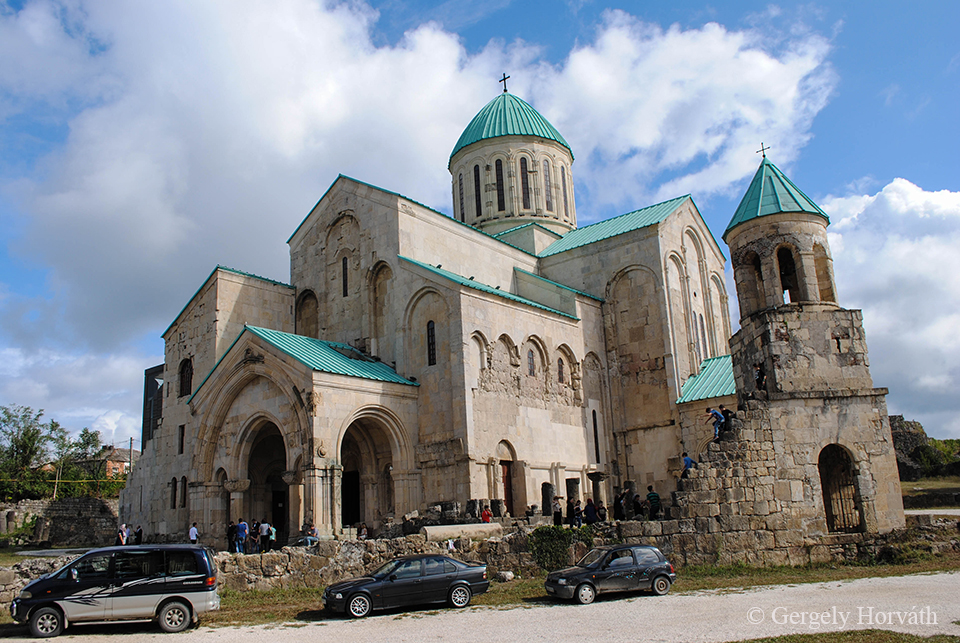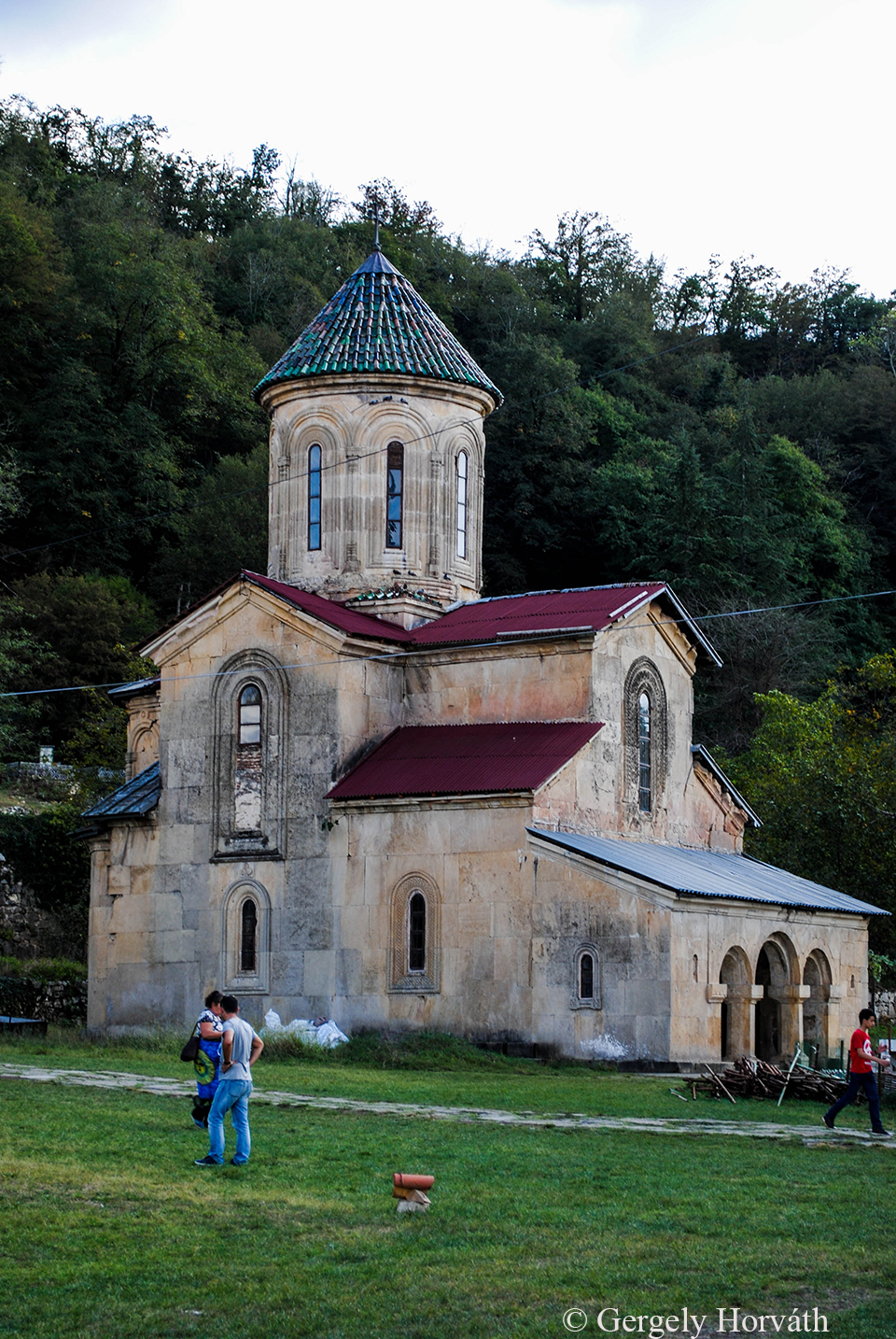Körutazásunk első állomása Kutaiszi volt, elsődlegesen azért, mert Budapest ennek a városnak a repterével áll közvetlen légi-összeköttetésben (nem mellékes apróság, hogy a Budapest-Kutaiszi járat közép-európai idő szerint 23.50 körül indul, ami 3 órás repüléssel plusz 2 óra időeltolódással számolva hajnali 5 órás érkezést jelent). A Kutaiszi reptérről lehetőség van ugyan marshrutkával, vagy taxival továbbindulni Tbiliszi felé (újabb 3 óra…), de mi úgy döntöttünk, hogy egy napot eltöltünk a városban (pihenés okán is), ugyanis látványosság mind Kutaisziben, mind a környéken szép számmal akad.
The first stop of our journey was in the town of Kutaisi, mainly because this is the destination of the only direct flight from Budapest to Georgia (also worth to mention the not so negligible fact that the plane departs around 11.50 pm CET and counting with 3 h of flight and 2 h of time difference it arrives around 5 am local time). Direct transport to Tbilisi is available from the airport (another 3 hours…), however, not so surprisingly we decided to rest and spend one day in Kutaisi, since must-sees are represented with high number in and around the town.
Először is pár alapvető adat Kutaisziről, melyet (Batumi mellett) Grúzia második fővárosaként is emlegetnek. Kutaiszi 200 ezer lakosával az ország második legnépesebb városa és már a kora ókortól kezdve jelentős település, hiszen számos államalakulat fővárosa volt a történelem során, melyek közül talán Kolkhisz (Kr. e. 13. sz - Kr. e. 164) volt a legjelentősebb (ide hajóztak el az Argonauták az aranygyapjút keresve). Ma Imereti tartomány székhelye és érdekes módon 2012 óta a grúz parlament is itt székel Tbiliszi helyett.
First a few facts about the town, which is often referred (together with Batumi) as the second capital of Georgia. With 200.000 inhabitants Kutaisi is the second most populous settlement in the country. Kutaisi was a significant town already during the ancient times as it was the capital of many states. The most famous and strongest of these was Colchis (13 th cent. BC - 164 BC), known as the legendary destination of the Argonauts during their search for the Golden Fleece. Nowadays Kutaisi is the seet of Imereti province and since 2012 the home of the Georgian parliament.

A város talán leghíresebb műemléke a Bagrati katedrális (hivatalos nevén Nagyboldogasszony Katedrális [teológiai ismereteim eléggé limitáltak, de az angol dormition kifejezést én így ültetném át magyarra, ez ugyanis általában Szűz Mária mennybemenetelét jelenti]), mely a 11. században épült, III. Bagrat király uralkodása alatt. A katedrális többször is megrongálódott a történelem folyamán - ebben a muszlim hódítóknak elég mélyen benne volt a kezük - és a 20. századot már elég romos állapotban érte meg. A feltárással egybekötött (ekkor még ráérős) rekonstrukciós munkálatok 1952-ben kezdődtek el. 1994-ben az UNESCO felvette a világörökségi listára, érdekes módon ellenezve a felújítást, a szervezet ajánlása szerint a katedrálisnak romos állapotban kell(ett volna) fennmaradnia az utókor számára. A grúz illetékeseket ez nem igazán hatotta meg így a már egyre nagyobb elánnal folyó felújítás (igazándiból újjáépítés) folytatódott tovább. Mai formájában 2012. szeptember 16.-án adták át. További érdekesség, hogy 2001 óta már nem igazán miséznek a katedrálisban, manapság szinte teljes egészében turistalátványosságként funkcionál.
The most important architectural landmark and main tourist attraction in the town is the Bagrati Cathedral (oficially Cathedral of the Dormition) built in the 11th century under the rule of Bagrat III. The cathedral was dameged and destroyed many times mostly as an outcome of constant wars fought against muslim invaders. By the 20th century only ruins of the original building remaind. Archeological excavations and reconstruction works began in 1952. In 1994 the ruins of the Cathedral was added to the UNESCO's World Heritage Site list with the recommendation that the site should kept in the form as a ruin and not to rebuild (which was in progress at the time). However, Georgian authorities continued the process and the cathedral was opened in it's current form on the 16th September 2012. Worth to mention that since 2001 the cathedral is owned by the Church but it's now of limited use of worship and functioning mainly as a tourist attraction.


Szállásunkat olyan szerencsésen sikerült kiválasztanunk, hogy pontosan átellenben esett a katedrálistól, szóval sokat nem kellett gyalogolnunk.
We were lucky since the cathedral was only a few steps away from our hostel.

Kutaiszi folyója, a Rioni két részre osztja a történelmi belvárost.
The Rioni river divides the historical centre of Kutaisi.

A grúz építészeti stílus eléggé szokatlannak hat európai szemmel. Ennek első példája ez a belvárosban található, bibliai elemekkel díszített szökőkút volt. A szökőkutak egyébként minden grúz város elmaradhatatlan tartozékai, általában prominens helyen felállítva.
Georgian architecture (style, no offence) might be a bit strange with a European standard. The first example of this fact was this fountain, depicting biblical motifs, from the centre of the town. Fountains are usually inevitable accessories of every Georgian town.

A város domborzatilag határzónában található, hiszen míg északról, északkeletről hegyek (Szamgurali hegyhát, Észak-Imereti dombvidék) délről és nyugatról a Kolkhiszi-síkság fogja közre.
The town located in a geographical boundary zone since Samgurali Range and North Imereti Foothils borders it from the North and North East, while the Colchis Plain from the West and South.

A környék másik fontos turistalátványossága a Kutaiszitől néhány kilométerre északra található Gelati kolostor, mely a 12. században, IV. Dávid (ismertebb nevén Építő Dávid) király uralkodása alatt épült. Hamar a királyság egyik legjelentősebb szakrális és kulturális központjává nőtte ki magát, hiszen az itt lakó szerzetesek egy akadémiát is fenntartottak ahol nem csak teológiát, hanem többek között filozófiát is magas szinten tanítottak (és persze bort is termeltek, mert az errefelé alapvető életműködésnek számít). A kolostor ma is Grúzia egyik legfontosabb vallási központja...
An other must see is the Gelati Monastery which situated from a few miles north from Kutaisi in the mountains. The monastery was built by the order of David IV. (known also David the Builder) and soon became one of the most important theological and cultural hubs of the kingdom. The monastery had a famous Academy where the most important scientists, theologists and philosphers of the age were employed (also, they produced wine since this is vital in this territory). The Gelati Monastery remaind the one of the most important religious centre of Georgia...

...ami sajnos ottjártunkkor épp felújítás alatt állt.
...which was unfortunately under reconstruction at the time of our visit.

Az alapító, Építő Dávid sírja a kolostor területén található. Építő Dávid a grúz történelem egyik legfontosabb alakja, akinek uralkodása alatt az egyesített Grúz Királyság a térség vezető állama volt, határait két tenger mosta (jó, az egyik gyakorlatilag tó, de azért mégiscsak nagyobb, mint a Balaton). Alakját a grúz egyház kanonizálta, így a hívők ottjártukkor szentekkel szemben tanúsított ortodox szokás szerint csókkal illetik a király sírját.
The tomb of David the Builder can be found in the monastery. David was one of the most prominent Georgian kings since under his rule the unified Georgian Kingdom became the strongest state in the area reached from the Black Sea to the Caspien Sea. He was canonized by the Georgian Church so believers kiss their grave as they do portraits of other orthodox saints as well.

A grúz királyok mindig is bőkezűek voltak, ha Gelati fejlesztéséről volt szó. A jótevők portréját a templom freskói is megörökítik. Jobb szélen Építő Dávid.
Georgian kings were always generous to Gelati and the portraits of the benefactors was immortalize on the murals of the Gelati church. On the right, David the Builder.

A templom belső tere, gazdagon díszített, a freskók Jézus életének történéseit, szenteket, mártírokat és bibliai részleteket örökítenek meg.
The inner walls of the church are richly decorated with scenes from the life of Jesus, portraits of saints, martyrs and events from the Bible.
Utazásunk következő szakaszában elhagytuk Kutaiszit és a főváros, Tbiliszi felé vettük az irányt.
In the next phase of our journey we lefts Kutaisi and travelled to the capital of Georgia, Tbilisi.